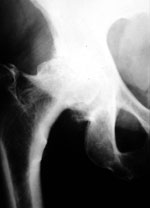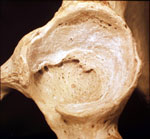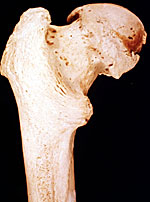
ARTHROSIS
| How to care Prostheses Surgery Rehabilitation | |||||||||
|
The most important function of the human body is movement. Muscles and articulations are responsible for mobility. The constant increase in life expectancy in industrialized countries also unavoidably raises the incidence of degenerative diseases of articulations (arthrosis). Articular arthrosis begins by a reduction in the thickness of the articular cartilage; in more advanced stages, the articular bone is progressively deformed (deforming arthrosis). Another interesting aspect in arthrosis research stems from the technological development of our society: we can witness, indeed, a large increase in “secondary” arthroses, that is, resulting from traumas. In fact, we all use, directly or indirectly, motor vehicles (accident traumatology); we more and more often dedicate our free time to one or more sports (sport traumatology); the number of traumas on the workplace is constantly increasing (working traumatology) etc. We have created, therefore, the ASGroup aimed at improving the prevention and, especially, the treatment of arthrosis, applying the most modern surgical techniques. Hips, knees and shoulders are the articulations the most affected by arthrosis, whose characteristics are the continuous increase in articular pain and the limitation of mobility.We can prevent arthrosis and the acceleration of the degenerative process by using preventive measures: increasing movement (walking, swimming, bicycle riding) and reducing charge (hence, the stress on the articulation). In the presence of a progression in the degenerative process, conservative therapies such as physiotherapy, thermal therapy and, if necessary, intra-articular injections of anti-inflammatory or chondro-protective drugs, are advised. In more advanced cases, characterized by strong functional limitations, modern surgical technologies of replacement of the worn-out articulation with artificial implants (arthroprostheses) can be used. These interventions guarantee, after a brief period of rehabilitation, the normal functioning of the articulation without any pain.. |
||||||||
ARTHROSIS: THE TREATMENT
| Arthrosis Prostheses Surgery Rehabilitation | ||
In the initial and intermediate phases, the treatment is conservative. Initial phases:
|
||
ARTHROSIS: PROSTHESES
| Arthrosis How to care Surgery Rehabilitation | ||
  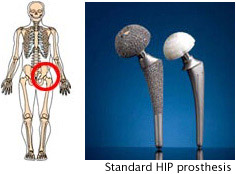 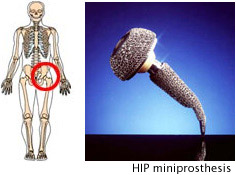  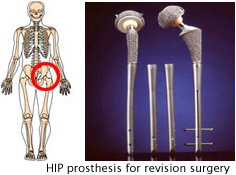 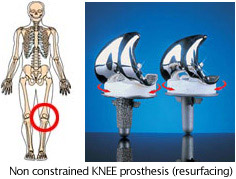 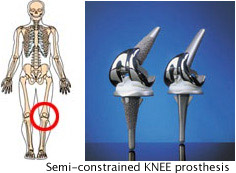 |
They represent artificial articulations differentiating according to the: Form
Biological fixation prostheses do not need any chemical element functioning as adhesive (cement). Thanks to their surface, they succeed in achieving a complete integration with the bone upon direct contact. These prostheses have the longest duration. The Arthro Surgery Group utilizes mainly biological fixation prostheses.
|
|
ARTHROSIS: SURGERY
| Arthrosis How to care Prostheses Rehabilitation | ||

|
The surgical operation lasts about 45 minutes and is performed under epidural anaesthesia, except extraordinary cases when the anaesthetist makes another decision. The use of blood transfusion from an external donor is no longer necessary because the blood of the patient himself is used (self-transfusion) or the intra- or post-surgical recovery of the patient’s blood is practiced by special disposable filters.. |
|
ARTHROSIS: REHABILITATION
| Arthrosis How to care Prostheses Surgery | ||
 |
The day after the surgical operation the patient can recover the standing position. Two days after surgery the patient begins to make the first steps with the help of two Canadian sticks. On the third–fourth day the patient is able to walk up and down the stairs, still with the help of two Canadian sticks. Then, the rehabilitation program goes on with the phase of muscular potentiation, which allows for the eventual elimination of the two Canadian sticks. This happens three months after surgery. 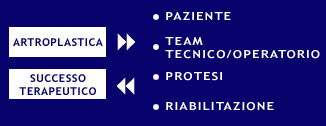 requisiti per successo terapeutico 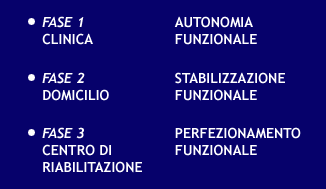 fasi della riabilitazione 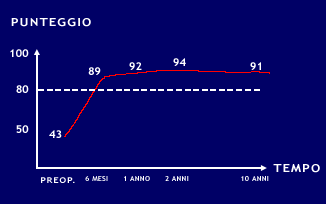 punteggi internazionali HARRIS |
|

